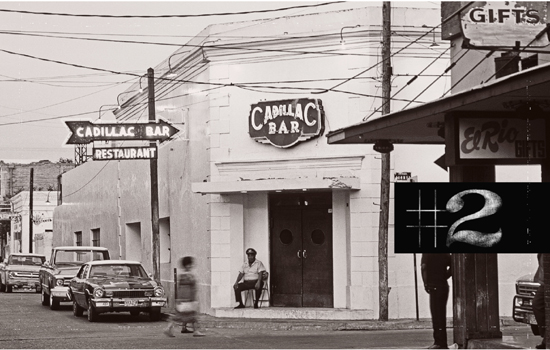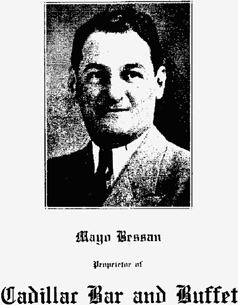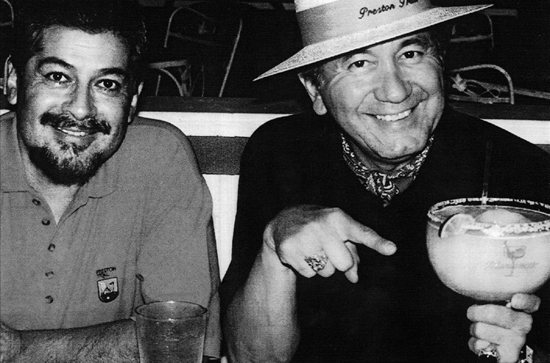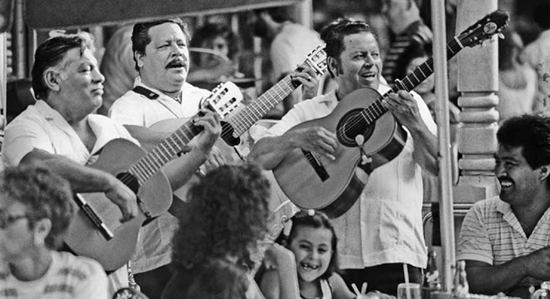
The original Cadillac Bar in Nuevo Laredo opened in 1926
In 1983, a hugely profitable 4,400-square-foot bar and grill in San Francisco called the Cadillac Bar started a new restaurant genre. There was a giant mesquite grill along one wall and you could smell grilled meat and mesquite smoke from way down the street. It was named after the original Cadillac Bar in Nuevo Laredo, Mexico, and was decorated with beer signs and memorabilia collected in the border towns along the Rio Grande. As a former Austinite living in San Francisco in the 1980s, I treated the Cadillac as my home away from home.
The original Cadillac Bar was opened in 1926, by a New Orleans waiter named Mayo Bessan. He moved to Nuevo Laredo, bought a bar called the Caballo Blanco, and changed the name to the Cadillac Bar. He chose the name because it sounded rich and because his target market was Texas. The bar specialized in the trendy drink of the era, the Ramos Gin Fizz.

“Big Daddy” Bessan didn’t know anything about Mexican food and he never learned Spanish. He didn’t need to. Thanks to Prohibition, droves of well-heeled Americans were crossing the border in search of refreshments and a night on the town. The Cadillac became their preferred destination. The menu was in English and the prices were in dollars. Entrees included Italian spaghetti with meatballs, New Orleans shrimp Creole, crab Newburg, and chicken mole Mexicana. The kitchen also offered broiled steaks, veal chops, lobster, and frog legs. And then there was the standard Mexican dinner combo plate.
The wild success of Nuevo Laredo’s Cadillac Bar inspired similar ventures in other border towns. Posh restaurants and night clubs on the other side included the Kentucky Club in Juárez, the Drive-In in Matamoros, and the Victory Club in Piedras Negras. They all catered to Americans crossing the border from Texas.
Bessan’s daughter Wanda and her husband, Porter Garner Jr., took over when Bessan retired and the Garners operated the Cadillac Bar until the late 1970s, when they turned the keys over to the employees and walked away. They could see the handwriting on the wall: there would soon be little reason to go to Mexican border-town bars like the Cadillac.
It was in 1970 that the “liquor by the drink” amendment passed the Texas legislature. It’s hard to believe, but cocktails weren’t available in Texas restaurants at the time. Shortly after the law changed, new Tex-Mex restaurants with expansive bars began to pop up, and they were modeled after the famous border-town cantinas.
The Cadillac Bar, and the enticing blend of luxury, liquor, and south-of-the-border dining that it represented, became the model for a new style of restaurant, the contemporary Tex-Mex bar and grill. A Cadillac Bar in San Antonio opened in 1973. The Landry’s restaurant group now operates a Cadillac Bar in Houston and another one in Kemah.
But it was the San Francisco Cadillac, with its giant mesquite grill and Mexican decorations, that became the most famous. Frozen margaritas and mesquite-grilled fajitas were the most popular order at the San Francisco restaurant. Large orders like mesquite-grilled cabrito and seafood platters that fed five or six people were among the other favorite dishes.
The owners of the San Francisco Cadillac Bar described their cooking as authentic Mexican and bragged that many of the recipes came from the namesake restaurant in Nuevo Laredo. They neglected to mention that Mayo Bessan was from New Orleans and that the Cadillac Bar was never an authentic Mexican restaurant. The frozen margaritas and grilled fajitas they were serving were pure Tex-Mex. But the mistaken belief among consumers that this was authentic Mexican fare turned out to be a godsend for Tex-Mex restaurant owners.
Cadillac manager and bartenders with dinner specials and cocktails
THE INVENTION OF THE FROZEN MARGARITA
The original margarita machine, a slightly altered frozen custard dispenser, is now in the Smithsonian Institution. Mariano Martinez, the man who made frozen margaritas famous, donated it to the museum some years ago.
In 2002, while I was doing research for The Tex-Mex Cookbook, I sat down with Martinez at the original Mariano’s Mexican Cuisine restaurant in Dallas, which is no longer in existence. The bar menu offered lots of top-shelf tequilas, but I ordered one of Mariano’s original frozen margaritas.
The tequila was really little more than a background flavor. The salt on the rim and the sweetness of the drink mix were far more pronounced than the liquor—which made the drink very popular with college kids and other imbibers on training wheels.
Over several of the icy cocktails, Martinez repeated the frozen margarita saga, a tale he has told countless times before: “When my father [Mariano Martinez Sr.] opened his restaurant, El Charro, in the 1950s, you couldn’t sell liquor by the drink in Texas. But he made frozen margaritas for people who brought their own tequila.”
Martinez’s frozen margarita was an adaptation of the frozen daiquiri, which had been popularized by the unlikely trio of Ernest Hemingway, Fred Waring, and John F. Kennedy. In the 1930s, Hemingway waxed eloquent about the frozen daiquiris at La Floridita bar in Havana, where they were made using shaved ice. Musician Fred Waring launched the blender in the late 1930s and sold hundreds of thousands of them before World War Two by whipping up instant frozen daiquiris wherever he went. JFK drank frozen daiquiris before dinner in the White House, which gave the drink a burst of publicity in the 1960s.
The blender recipe for a frozen daiquiri was rum, lime juice, ice, and a sweetener. Substitute tequila for rum and you get a frozen margarita. The drink was little more than a curiosity in the 1960s, a way to use that souvenir bottle of tequila you brought home from your Mexican vacation.
“When I opened this restaurant in 1971, people came to me for margaritas, too,” says Martinez. “Dad gave me his recipe—it was tequila, lime juice, and orange liqueur. His secret ingredient was a splash of simple syrup. You put it in the blender with ice until it got slushy.”
When cocktails became legal, Martinez wanted to make Mariano’s Mexican Cuisine the Dallas destination for frozen margaritas. “I taught my bartender how to make the drink, but people complained about it. They said it tasted different every time. I tried to talk to the bartender about it one night, but he was sick of squeezing all those limes and threatened to quit,” remembered Martinez.
“The next morning I was getting coffee at the Seven-Eleven and saw some kids getting icees out of the machine,” he said. “That’s when it hit me.” 7-Eleven wasn’t eager to help him purchase the machines, so Martinez ended up buying a soft-serve ice cream machine. “We tinkered with the machine and the recipe for a long time,” he laughed. “We had a lot of tasting parties.”
When you make a frozen margarita in a blender, you dilute the drink with added ice, he explained. But if you put the same ingredients in an ice cream machine they won’t freeze because the alcohol content is too high. First, he experimented with diluting the solution with enough water to allow it to freeze. But the resulting cocktail tasted too weak. The solution, Martinez told me, was to increase the sugar. With a high enough brix level (the scientific measurement of sugar content), you can freeze quite a bit of alcohol.
The sweet frozen margaritas at Mariano’s Mexican Cuisine became an instant sensation. The Dallas Cowboys drank them; Trini Lopez and Lee Trevino drank them. But it was coeds from nearby Southern Methodist University who really spread the drink’s fame. Mariano Martinez now owns several successful Tex-Mex restaurants in Dallas, and all of them serve margaritas.
Mariano Martinez never received a patent or trademark for his idea. He doesn’t think it would have been possible anyway. “I just started making margaritas in a machine that already existed,” he shrugged.
“I go places now and I tell people I invented the frozen margarita, and they say, ‘Yeah, right.’ ”

Father of the frozen margarita, Mariano Martinez (left), with Trini Lopez
In 1972, a hugely influential cookbook called The Cuisines of Mexico by Diana Kennedy trashed the “mixed plates” that were sold as Mexican food north of the border. Kennedy’s dim view of Tex-Mex was endorsed by her friend Craig Claiborne at the New York Times. Knowledgeable food lovers began to demand authentic Mexican cooking and to snub Tex-Mex. And as a result, countless Mexican-American families watched their restaurants go out of business.
Sizzling fajitas and frozen margaritas saved the day. They also changed the architecture. Vintage Tex-Mex restaurants didn’t have bars, but from the 1970s on, the bar became the center of nearly every Tex-Mex restaurant that wasn’t in a dry county. Along with the new focus on the bar came a different atmosphere.
Customers had once gone to mom-and-pop Tex-Mex diners to enjoy a combo platter and depart, but the festive new cantinas were designed to be hangouts. Many featured outdoor seating on patios or decks. The gang who went to get a drink after work now included more women and they favored the new Tex-Mex bar and grill over male-dominated bars and taverns. Happy-hour margarita drinkers made communal cocktail snacks or botanas like nachos and fajitas more popular than old-fashioned combo platters.
“The frozen margarita made tequila an acceptable drink for women,” observed Marc N. Scheinman, marketing professor at Pace University’s Lubin School of Business and the author of a study titled “The Global Market for Tequila.”
“The spread of the frozen margarita coincided with large numbers of young women coming into the workforce,” said Scheinman. “It also coincided with a rise in immigration and the Mexicanization of American cuisine.”
The frozen margarita rocked the liquor business. Between 1975 and 1995, tequila sales in the United States increased more than 1,500 percent. From 1995 to 2005, sales doubled again. In the early 1990s, tequila producers were overwhelmed by the demand. They were running out of agave. The potential loss of revenues prompted the regulatory body that supervises tequila production in Mexico to liberalize the rules.
Whereas all tequila was once made with 100 percent agave, now tequila could be distilled from 51 percent agave supplemented with cane sugar. The result was cheap tequila bottled solely for the purpose of making margaritas. The cheap tequilas gave the frozen margarita a bad name and inspired tequila lovers to become more discerning in their purchases. Shaken margaritas, sometimes known as “Mexican martinis” were considered better showcases for premium tequilas.
The United States surpassed Mexico in tequila consumption in 2000 and the market continues to grow, fueled by the nation’s insatiable demand for margaritas. In Mexico, where tequila is a macho drink taken neat with a chaser, the American frozen cocktail is beginning to make headway among Mexican women. The drink is also gaining ground in Europe and other parts of the world as Tex-Mex continues to grow in popularity.
In August 2005, Brown-Forman, the liquor marketing giant that owns Jack Daniel’s, bought the Herradura tequila distillery for $876 million. At a time when all other categories of hard liquor were either declining or showing flat sales, liquor companies spent their money on the only category that showed any growth. The next time you fire up the blender, consider the way the frozen tequila cocktail redefined the way we eat.
EXPENSIVE TEQUILA
Reposado and añejo tequilas are aged in oak casks so they are easy to sip, and their mellow flavor is lost in a glass of lime juice. Making a frozen margarita with expensive tequila is like making a whiskey sour with single-malt scotch.
The bold, vegetal flavor of plata (silver) tequila makes a great margarita. Low-end 100-percent-agave tequilas start at around fifteen dollars a bottle and they are a good choice for frozen margaritas.
Super-premium tequilas, like Centinela, Herradura, El Tesoro, and Chinaco, go for between thirty and sixty dollars a bottle. Super-premium tequilas account for 7.4 percent of the 4.5 million cases of tequila that sold in the United States in 2006. And sales of super-premiums are growing at about 15 percent a year.
Beyond super-premium, there are the new ultra-premiums, which include Don Julio Real tequila at $312 and Gran Patrón Platinum at $203 a bottle. The most expensive tequila sold in Texas is Herradura Seleccion Suprema at $342 for a 750-milliliter bottle.
3 shots tequila plata
1 shot Grand Marnier
½ cup frozen limeade concentrate
2 cups crushed ice
Coarse salt
Lime wedge
VARIATIONS
PSYCHEDELIC PURPLE SWIRL MARGARITAS
Pour a shot of pomegranate concentrate into a salted glass, then pour the slush over the top so it swirls throughout.
ASTROTURF GREEN SWIRL MARGARITAS
Pour a shot of Midori melon liqueur into a salted glass, then pour the slush over the top so it swirls throughout.
Waiter with a tray of hot plates in the kitchen of the original Cadillac Bar
1 cup sugar
The strolling musicians are really ripping it up. You’ve had a few margaritas and you’re all caught up in the spirit. So when the mariachi band appears at your table, you hand them a couple of bucks and sit back to savor the serenade.
“What would you like to hear?” asks the guy with the big guitar. You open your mouth but nothing comes out. What are you going to request? They just played “La Bamba,” “Guantanamera,” and “Rancho Grande” for the clueless gringos at the last table.
Here’s a list of five very cool mariachi songs:
1. “TÚ, SÓLO TÚ” (unrequited love)
Note the easy-to-remember title, which means “you only you.” This Pedro Infante song makes quite an impression on first dates. “See how I’m going around, woman, drunken and passionate for your love …”
2. “VOLVER, VOLVER” (broken-hearted about a girl)
This José Alfredo Jiménez classic is one of the best tears-in-the-beer songs ever written. All the drunk guys at the bar will join in on the chorus.
3. “MI RANCHITO” (broken-hearted about a ranch)
Does he miss the little ranch or the woman he left behind there more? I’m guessing the ranch.
4. “PA’ TODO EL AÑO” (to kick off a suicidal year-long binge)
My personal favorite is about a guy planning to drink a whole year away and blame it on a woman. “I’m brave enough not to deny it, and I’ll shout that it’s for your love that I am killing myself.”
5. “GRITENME PIEDRAS DEL CAMPO” (talking to the landscape in love)
Extra credit for remembering the difficult title. Great for occasions when you’re out of control and conversing with inanimate objects: “Talk to me, mountains and valleys. Scream to me, stones in the field. When have you ever seen anyone love like I am loving, cry like I am crying, die like I am dying.”

½ small watermelon
8 ounces Simple Syrup
4 ounces freshly squeezed lemon juice
4 ounces freshly squeezed lime juice
12 ounces gold tequila
8 ounces watermelon liqueur
12 mint leaves
The late Matt Martinez Jr. with a frozen margarita outside his family’s restaurant in Austin
The menu at the original Cadillac Bar featured steaks, chops, wild game, spaghetti and meatballs, and New Orleans shrimp Creole along with baked cabrito and a Mexican dinner
1½ ounces dry gin
½ ounce freshly squeezed lemon juice
½ ounce freshly squeezed lime juice
2 tablespoons cream
1 egg white (or powdered egg whites)
¼ ounce club soda, plus more to taste
1 tablespoon powdered sugar
3 to 4 dashes of orange flower water (essential, but hard to find)
CADILLAC “EGG DRINKS”
THERE WERE more than half a dozen “egg drinks” on the menu at the Cadillac Bar, including four fizzes and three flips. Egg drinks became rare because of the labor involved to make them and because of a fear of salmonella contamination from raw eggs. The drink has to be shaken for quite a while to get the ice cubes to agitate the eggs enough to cause them to foam. In New Orleans, the drink was shaken for up to five minutes; sometimes the shaker was passed from one bartender to another. You can cheat and whip the drink without ice in your blender. Powdered egg whites take the fear out of using eggs.

The first red grapefruit was discovered in Texas in 1929 growing on a pink grapefruit tree. Horticulturists at Texas A&M University developed the Ruby Red cultivar from the seeds of that natural mutation. While changing citrus groves from one variety to another is usually a long process, severe freezes in the 1950s speeded up the replanting process in South Texas. As a result, Texas quickly acquired the reputation as the leading producer of red grapefruit.
In an attempt to stimulate more mutations, scientists bombarded red grapefruit seeds and budshoots with gamma rays. That’s how the Rio Red variety was developed. And when two more severe freezes in the 1980s killed many older trees, much of the valley was replanted in this new redder variety. Those trees are now bearing the new generation of grapefruit. While the deep ruby color probably doesn’t make the Rio Red grapefruit taste any better, thanks to high levels of lycopene, it might make it better for your health. Both pink and red grapefruits contain lycopene, but the highest concentrations are in the reddest grapefruit, such as the Rio Star.
The names of the varieties get pretty confusing. Marketing executives are trying to sell “Texas red grapefruit” as a blanket term. But there is a difference between the cultivars. Rio Star and Ruby Red are the two varieties you are most likely to see. They both taste about the same, but the new Rio Star variety is darker red and keeps its color throughout the season. Ruby Red is the original red grapefruit. Its color fades to pink as the season progresses. While other states grow these varieties too, Texas-grown red grapefruit regularly trounces all competitors in blind tastings.
The secret of the great taste is something growers call the “sugar to acid ratio.” While Texas grapefruits actually have about the same sugar level as comparable fruit from other places, they have less acid and therefore less sourness. Texas growers brag that they have “taken the pucker out of grapefruit.”

Coarse sea salt
4 shots freshly squeezed red grapefruit juice
1 shot plata tequila
¡ASK A MEXICAN! SEAL OF APPROVAL

“¡ASK A MEXICAN!” columnist, Gustavo Arellano, drank quite a few of these salty grapefruit-and-tequila cocktails the last time we got together, and he gave the drink his personal seal of approval.
½ lime
Coarse sea salt
2 dashes Worcestershire sauce
1 teaspoon Tabasco or other hot pepper sauce
12 ounces Mexican beer
A wave of German and Czech (Bohemian and Moravian) immigration in the mid to late 1800s supplied Mexico with skilled brewers and influenced its style of beer-making forever after. Founded in 1890, Monterrey’s Cervecería Cuauhtémoc Moctezuma was the first major brewery in Mexico. Brands that are popular in the United States include Dos Equis (XX) Amber, a lighter style of a Viennese lager, and Bohemia, which is modeled after a Czech pilsner.
Negra Modelo, a dark and malty Vienna lager, is produced by Cervecería Cuauhtémoc’s competitor, Grupo Modelo, in Mexico City. The second largest brewery in the country, Grupo Modelo also makes the number-one-selling Mexican beer in the United States, Corona.
In 1998 a microbrewery began producing remarkable small-batch ales under the name Casta (Spanish for “purity”) in Monterrey. Casta Dorada (“golden”) is a slightly sweet brew with cinnamon aromas. Casta Bruna is an excellent English-style brown ale, while Casta Morena (“brunette”) is a thick and creamy stout. Many beer geeks think Casta makes the best beers Mexico has to offer.
It’s nearly impossible to find in the United States, so if you’re looking for a souvenir to bring home from Monterrey, consider bringing home a case of Castas.

San Antonio Brewer’s Association members, 1895
MY TOP 10 TEXAS MICROBREWERY BEERS
The first breweries in Texas appeared around 1840 in areas settled by Germans. These tiny operations would be called craft breweries today: they made highly individual beers in small quantities for local markets. Without ice or refrigeration, they could only brew during the colder months.
In 1877 the king of German lager-style breweries, Anheuser-Busch of St. Louis, came to Texas. There were some seventy breweries in the state when Anheuser-Busch arrived. The national brewery sold a consistent lager beer, advertised heavily, and bought up Texas ice houses. Undercapitalized and unable to compete, native Texas breweries began to decline. By the time Prohibition arrived in 1918, there were only eighteen breweries left in Texas.
Texas microbreweries are now making a comeback. Some of the beers brewed in small Texas operations have won national acclaim. Here’s a list of my favorite modern Texas microbrews:
AVAILABLE YEAR-ROUND:
1. SAINT ARNOLD ELISSA
If you love crisp, bitter, hoppy beers, you will fall hard for this India Pale Ale (IPA) named after Galveston’s tall ship.
Live Oak beers are sold on draft to select pubs and restaurants around the state that cater to beer lovers. All of their beers are extremely well made, but the Czech-style pilsner is spectacular.
3. REAL ALE FULL MOON PALE RYE ALE
The hippest brewer in Texas, Real Ale in Blanco makes this unusually crisp, rye-flavored ale that goes exceptionally well with food.
The Fort Worth microbrewery’s number-one seller is a German schwartzbier made with dark roasted malts for a rich flavor and dark color.
5. SHINER BOHEMIAN BLACK LAGER
Another German schwartzbier; this one was made to celebrate the brewery’s anniversary, but it was so popular it’s now made year round. Shiner’s number-two seller after Shiner Bock and much more interesting.
SEASONAL FAVORITES:
6. REAL ALE SHADE GROWN COFFEE PORTER
Available on draught in the wintertime, this intense porter is made with Katz fair-trade coffee.
7. SAINT ARNOLD SUMMER PILS
Crisp, refreshing, delicious summer Czech-style pilsner.
8. RAHR & SONS BUCKING BOCK
A sweet, golden Maibock (spring bock) that’s shockingly good.
9. LIVE OAK HEFEWEIZEN
You can get this spring and summer wheat beer with live yeast and citrus flavors on draught only—but it’s one of the best HefeWeizens in the country.
10. SAINT ARNOLD CHRISTMAS ALE
Lots of malt, lots of hops, and lots of alcohol make this sweet, spicy, hearty ale a favorite for the holiday season.
Do-it-yourself Bloody Mary buffet at the Cadillac Bar in Houston
BLOODY MARY MIX
1 quart Spicy V-8
3 tablespoons Worcestershire sauce
Juice of a Mexican or Key lime
1 tablespoon red pepper flakes
1 tablespoon cracked black pepper
1 teaspoon minced fresh cilantro
FOR THE BAR
Vodka
Tequila
Celery stalks
Olives
Cocktail onions
Celery salt
Prepared horseradish
Worcestershire sauce
Tabasco and other bottled hot sauces
Black pepper
Sea salt